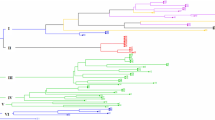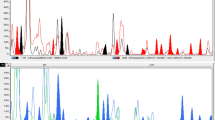Abstract
Three hundred and seven accessions of Aegilops tauschii Coss., including 160 of subsp. tauschii and 147 of subsp. strangulata, representing all the species range—from Turkey to Kirgizstan, were analyzed electrophoretically. Twenty polymorphic enzyme-encoding loci were studied, 10 of which were essentially polymorphic in Ae. tauschii. Climatic data for each of the 307 Ae. tauschii habitats were taken from WORLDCLIM database of computer system ArcGIS. Forty-nine climatic parameters were considered: precipitation, minimum, mean and maximum temperatures for each month, and also the total annual level of precipitation. The data were analyzed with multivariate statistical methods, such as Principal Components Analysis (PCA), Multiple Correspondence Analysis (MCA) and Two-Block Partial Least Squares. Variability of climatic conditions among Ae. tauschii habitats is reflected by the two approximately orthogonal “vectors”. The “first vector” is mostly determined by negative impact of precipitation and minimum temperatures during winter. The “second vector” is mostly determined by negative impact of maximum temperatures during summer, and positive impact of precipitation during late spring and summer. Aegilops tauschii is essentially variable along the “second vector”, and especially high level of variation is characteristic for subsp. tauschii. This variation reflects that Ae. tauschii is very tolerable to the climatic variation during summer season. Aegilops tauschii subsp. strangulata is also characterized by the high level of variation along the “first vector”. Moreover, all the habitats of subsp. strangulata fall into the two distinct separate clusters: the habitats in Precaspian Iran, which have the highest minimum temperatures in winter,—and all the other habitats. In the plot of the first two factors of PCA, the “cluster of Precaspian Iran” can be further divided into “Western Precaspian Iran (WPI)”, having relatively higher level of annual rainfall, and relatively dryer “Eastern Precaspian Iran (EPI)”. This three groups of subsp. strangulata accessions, from WPI, EPI and other areas, are also distinctly differed in enzyme-encoding genes allelic variation, as revealed on the plot of the first two axes of MCA. In contrast to subsp. strangulata, the level of variation of subsp. tauschii along the “first vector” is rather low. It was pointed out that variation along “the first vector” reflects adaptive intraspecies divergence of Ae. tauschii: its subspecies strangulata “prefers” the habitats of seaside climate, with warm and moist winter; while subsp. tauschii mostly occupies the habitats with rather continental climate, with relatively cold and dry winter. Allelic variation of enzyme-encoding genes Acph1, Ak, Est2, Est5, Got1, Got2, and Got3 correlate with climate along “the first vector”. Apparently, polymorphism of these loci were involved into the process of Ae. tauschii intraspecies adaptive divergence. Allelic variation of Cat2 and Fdp loci correspond to climatic variation along “the second vector” in subsp. tauschii. Therefore Cat2 and Fdp are likely to be among the genes which polymorphism “helped” subsp. tauschii to succeed in vast geographical expansion far to the east from Caspian Sea.












Similar content being viewed by others
References
Brown AHD, Nevo E, Zohary D, Dagan O (1978) Genetic variation in natural populations of wild barley (Hordeum spontaneum). Genetica 49:97–108
Chambers GK (1988) The Drosophila alcohol dehydrogenase gene-enzyme system. Adv Genet 25:39–107
Chenicek KJ, Hart GE (1987) Identification and chromosomal locations of aconitase gene loci in Triticeae species. Theor Appl Genet 74:261–268
Dudnikov AJ (1998) Allozyme variation in Transcaucasian populations of Aegilops squarrosa. Heredity 80:248–258
Dudnikov AJ (2000) Multivariate analysis of genetic variation in Aegilops tauschii from the world germplasm collection. Genet Resour Crop Evol 47:185–190
Dudnikov AJ (2001) Multiple correspondence analysis in genetic research: a program for PC. In: Pshenichnikova TA, Worland AJ (eds) Proceedings of 11th EWAC conference, 24–28 July, 2000. Institute of Cytology and Genetics, Novosibirsk, pp 108–113
Dudnikov AJ (2003a) Allozymes and growth habit of Aegilops tauschii: genetic control and linkage patterns. Euphytica 129:89–97
Dudnikov AJ (2003b) Germination capacity is in line with the allelic constitution of enzyme-encoding genes in Aegilops tauschii. Cereal Res Commun 31:403–406
Dudnikov AJ (2009) Searching for an effective conservation strategy of Aegilops tauschii genetic variation. Cereal Res Commun 37:31–36
Dudnikov AJ (2012a) Chloroplast DNA non-coding sequences variation in Aegilops tauschii Coss.: evolutionary history of the species. Genet Resour Crop Evol 59:683–699
Dudnikov AJ (2012b) Geographic patterns of histone H1 encoding genes allelic variation in Aegilops tauschii Coss. (Poaceae). Mol Biol Rep 39:2355–2363
Dudnikov AJ (2013) Geographic patterns of low-polymorphic enzyme-encoding genes allelic variation in Aegilops tauschii Coss. J Syst Evol 51:715–721
Dudnikov AJ, Kawahara T (2006) Aegilops tauschii: genetic variation in Iran. Genet Resour Crop Evol 53:579–586
Dudnikov AJ, Gorel FL, Berdnikov VA (2002) Chromosomal location of histone H1 genes in common wheat. Cereal Res Commun 30:55–61
Eanes WF, Kirchner M, Yoon J, Biermann CH, Wang IN et al. (1996) Historical selection, amino acid polymorphism and lineage-specific divergence at the G6pd locus in Drosophila melanogaster and D. simulans. Genetics 144:1027–1041
Eig A (1929) Monographisch-kritische Übersicht der Gattung Aegilops. Repertorium Speciorum Novarum Regni Vegetabilis Beihefte 55:1–228
Fildes RA, Harris H (1966) Genetically determined variation of adenylate kinase in man. Nature 209:261–263
Gottlieb LD (1981) Gene number in species of Astereae that have different chromosome numbers. Proc Natl Acad Sci USA 78:3726–3729
Hammer O, Harper DAT, Ryan PD (2001) PAST: paleontological statistics software package for education and data analysis. Palaeontol Electron 4(1):9 pp
Hart GE, Langston PJ (1977) Chromosomal location and evolution of isozyme structural genes in hexaploid wheat. Heredity 39:263–277
Jaaska V (1980) Electrophoretic survey of seedling esterases in wheats in relation to their phylogeny. Theor Appl Genet 56:273–284
Jaaska V (1981) Aspartate aminotransferase and alcohol dehydrogenase enzymes: intraspecific differentiation in Aegilops tauschii and the origin of the D genome polyploids in the wheat group. Pl Syst Evol 137:259–273
Jones H, Gosman N, Horsnell R, Rose GA, Everest LA, Bentley AR, Tha S, Uauy C, Kowalski A, Novoselovic D, Simek R, Kobiljski B, Kondic-Spika A, Brbaklic L, Mitrofanova O, Chesnokov Y, Bonnett D, Greenland A (2013) Strategy for exploiting exotic germplasm using genetic, morphological, and environmental diversity: the Aegilops tauschii Coss. example. Theor Appl Genet 126:1793–1808
Kilian B, Mammen K, Millet E, Sharma R, Graner A, Salamini F, Hammer K, Özkan H (2011) Aegilops. In: Kole C (ed) Wild crop relatives: genomic and breeding resources. Cereals. Springer, Berlin, pp 1–76
Kimber G, Feldman M (1987) Wild wheat. An introduction. Special report 353. College of Agricultural University of Missouri, Columbia, pp 1–142
Kimura M (1983) The neutral theory of molecular evolution. Cambridge University Press, Cambridge
Lebart L, Morineau A, Warwick KM (1984) Multivariate descriptive statistical analysis. Wiley, New York
Migushova EF, Remizova EP (1978) Winter and spring growth habit in genus Aegilops L. Bull NI Vavilov Inst Plant Ind 84:62–64 (in Russian)
Mizuno N, Yamasaki M, Matsuoka Y, Kawahara T, Takumi S (2010) Population structure of wild wheat D-genome progenitor Aegilops tauschii Coss.: implications for intraspecific lineage diversification and evolution of common wheat. Mol Ecol 19:999–1013
Nevo E, Zohary D, Beiles A, Kaplan D, Stroch N (1986) Genetic diversity and environmental associations of wild barley, Hordeum spontaneum, in Turkey. Genetica 68:203–213
Nevo E, Korol AB, Beiles A, Fahima T (2002) Evolution of wild emmer and wheat improvement. Population genetics, genetic resources, and genome organization of wheat’s progenitor, Triticum dicoccoides. Springer, Berlin
Pestsova E, Korzun V, Goncharov NP, Hammer K, Ganal MW, Röder MS (2000) Microsatellite analysis of Aegilops tauschii germplasm. Theor Appl Genet 101:100–106
Powers DA, Lauerman T, Crawford D, DiMichele L (1991) Genetic mechanisms for adapting to a changing environment. Annu Rev Genet 25:629–659
Richardson BJ, Baverstock PR, Adams M (1986) Allozyme electrophoresis. Academic Press, Australia
Rohlf FJ, Corti M (2000) Use of two-block partial least squares to study covariation in shape. Syst Biol 49:740–753
Saeidi H, Tabatabaei BES, Rahimmalek M, Talebi-Badaf M, Rahiminejad MR (2008) Genetic diversity and gene-pool subdivisions of diploid D-genome Aegilops tauschii Coss. (Poaceae) in Iran as revealed by AFLP. Genet Resour Crop Evol 55:1231–1238
Sohail Q, Shehzad T, Kilian A, Eltayeb AE, Tanaka H, Tsujimoto H (2012) Development of diversity array technology (DArT) markers for assessment of population structure and diversity in Aegilops tauschii. Breed Sci 62:38–45
Takumi S, Mizuno N, Okumura Y, Kawahara T, Matsuoka Y (2008) Two major lineages of Aegilops tauschii Coss. revealed by nuclear DNA variation analysis. In: Appels R et al. (eds) Proceedings of the 11th international wheat genetics symposium. http://hdl.handle.net/2123/3432. Sydney University Press, Sydney, Australia
Tang KS, Hart GE (1975) Use of isozymes as chromosome markers in wheat—rye addition lines and triticale. Genet Res 26:187–201
van Slageren MW (1994) Wild wheats: a monograph of Aegilops L. and Amblyopyrum (Jaub. & Spach) Eig (Poaceae). Wageningen Agricultural University Papers, Wageningen, The Netherlands
Acknowledgments
I wish to express my sincere gratitude to Mr. Denis Popov, Prof. Vadim M. Efimov and Dr. Vera S. Bogdanova for the help in the course of this study. I am also very grateful to the Editor-in-Chief, Prof. Karl Hammer and the anonymous reviewer for the detailed comments which helped much to amend the manuscript. The work was supported by Russian Foundation for Fundamental Research, grant 13-04-01117-a.
Author information
Authors and Affiliations
Corresponding author
Electronic supplementary material
Below is the link to the electronic supplementary material.
Rights and permissions
About this article
Cite this article
Dudnikov, A.J. Aegilops tauschii Coss.: allelic variation of enzyme-encoding genes and ecological differentiation of the species. Genet Resour Crop Evol 61, 1329–1344 (2014). https://doi.org/10.1007/s10722-014-0115-4
Received:
Accepted:
Published:
Issue Date:
DOI: https://doi.org/10.1007/s10722-014-0115-4




